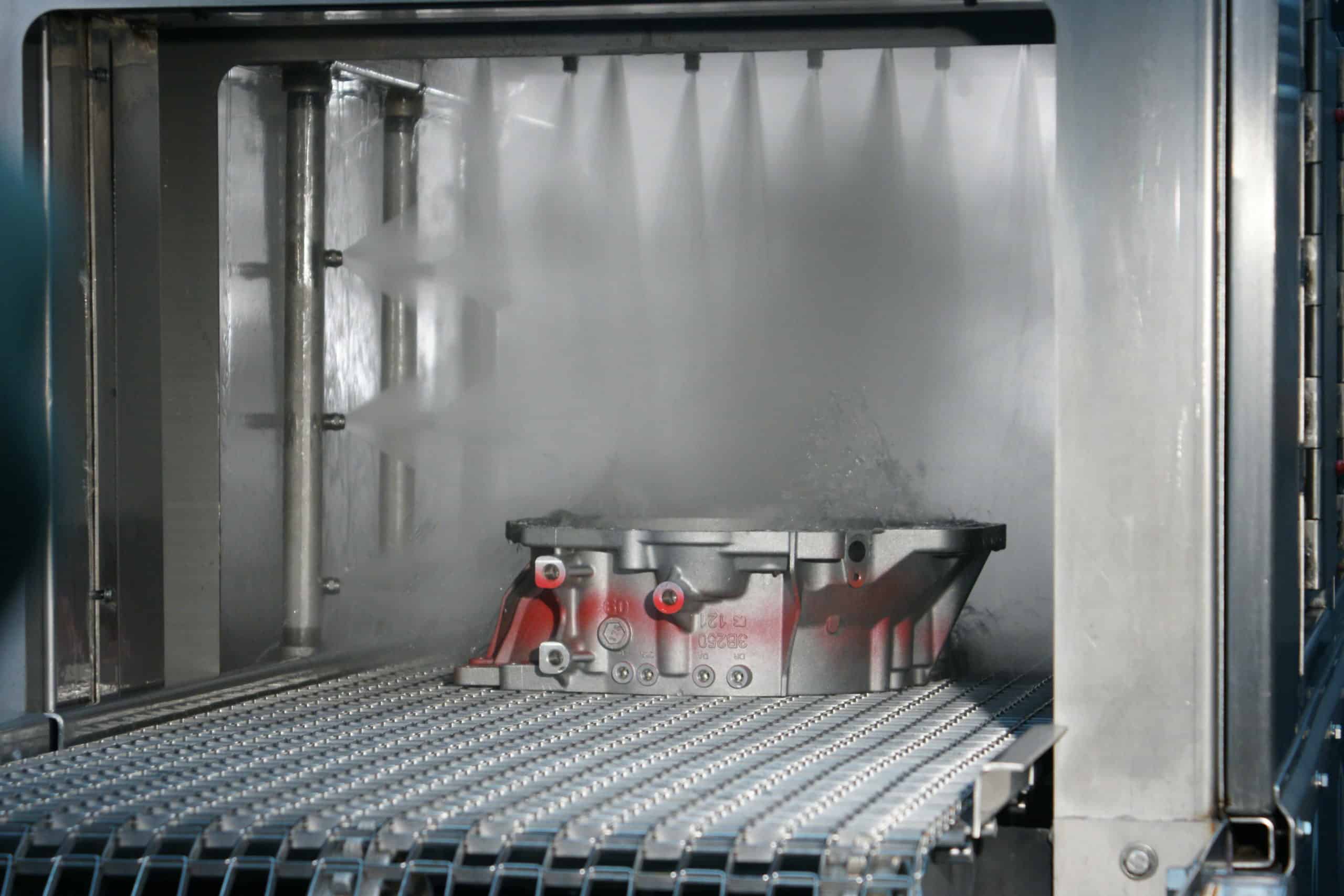What are the stages of industrial parts cleaning and sanitation?
Industrial parts cleaning is an essential part of any production process, and mastering the art of it can ensure that all parts are clean and safe to use. It is a complex process that involves multiple stages, and it is important to understand each step before attempting it on your own. In this blog post, we will be going over the essential steps of industrial parts cleaning in a step-by-step guide so you can confidently tackle this important task.
There are three main stages to industrial parts cleaning and product sanitization: washing, rinsing, and drying and the cleaning stages for industrial washers can be just as varied as the parts themselves. As such, you must have resources available about industrial parts cleaning to carefully consider the technologies you want to use to maintain the integrity of your piece.
What is the importance of industrial parts cleaning?
Effective industrial parts cleaning is essential for maintaining the reliability, safety, and quality of various manufacturing and industrial processes. Dirty, contaminated, or poorly maintained machinery can lead to production delays, product defects, and workplace hazards. Therefore, implementing a proper industrial parts cleaning protocol can significantly enhance the performance and efficiency of your operations while minimizing downtime, costs, and risks.
In addition, industrial parts cleaning also plays a vital role in complying with regulatory standards and environmental requirements. Various industries, such as food processing, medical device manufacturing, and aerospace engineering, must meet strict sanitation and cleanliness standards to ensure consumer safety, product integrity, and industry compliance.
Overall, industrial parts cleaning should be an integral part of any industrial or manufacturing process. It not only enhances operational performance and quality but also ensures workplace safety, environmental compliance, and consumer trust.
Types of Industrial Parts Cleaning Systems
Industrial cleaning systems have evolved significantly to address the complex and varied cleaning requirements found in modern industrial environments. These systems utilize advanced technologies and specialized equipment to efficiently remove contaminants, maintain hygiene, and ensure the smooth operation of machinery and facilities. The following are some of the most common types of industrial cleaning systems, each designed to tackle specific challenges and applications within different sectors.
-
Cabinet Part Washers (Purifier Series)
-
Heavy-duty spray cabinet washers use a rotating turntable to expose parts to high-pressure, aqueous-based cleaning solutions. They are ideal for removing tough contaminants like oils, grease, and grime from large or heavy parts. Available in multiple cabinet styles and customizable for wash, rinse, and dry stages.
-
-
Conveyor Washers (Cyberjet Series)
-
Modular, in-line tunnel washers are designed for high-volume, continuous cleaning of parts as they move along a conveyor belt. These systems can be configured with multiple stages (wash, rinse, dry) and are suitable for industries like automotive, aerospace, and food processing.
-
-
Precision Cleaning Turntable Washers (Ultima Series)
-
Turntable-style washers are engineered for applications requiring the highest cleanliness standards, such as aerospace, medical, and electronics. These systems offer advanced features for precision cleaning and can be customized for specific regulatory requirements.
-
-
Immersion & Ultrasonic Washers (ImmersoSonic Series)
-
These systems fully submerge parts in heated cleaning solutions, and are often combined with ultrasonic agitation. This method is highly effective for cleaning intricate parts with blind holes or complex geometries, as the ultrasonic waves help dislodge contaminants from hard-to-reach areas.
-
-
Rotary Basket Washers (Cyclojet Series)
-
Rotary systems combine tumbling or orbital motion with spray, immersion, and optional ultrasonic cleaning. They are designed for batch cleaning of small, complex components. These washers are especially effective for parts with blind holes or delicate features.
-
-
Drum Washers
-
High-capacity systems for cleaning large volumes of small parts, such as stamped or machined components. Parts are loaded into a rotating drum, where they are cleaned through a combination of tumbling and spray action.
-
- Air Rinsing Systems
-
Waterless, sustainable cleaning solutions that use heated, ionized air to remove particulates and neutralize static charges. Ideal for sensitive applications where moisture or chemical residues are unacceptable, such as electronics, aerospace, and medical devices.
-
What are the four main stages of industrial parts cleaning?
The process of industrial parts cleaning involves several stages to ensure that all parts are thoroughly cleaned and free from contaminants. While the specific steps may vary depending on the type of parts and the cleaning system being used, there are generally four main stages in the industrial parts cleaning process.
- The first stage is pre-cleaning, which involves removing any large debris or contaminants from the parts. This can be done through manual brushing, blasting, or using ultrasonic cleaners to agitate the parts and dislodge any dirt or grime.
- After pre-cleaning, the parts move on to the second stage, which is the cleaning stage. In this stage, the parts are immersed in a cleaning solution or solvent, or they may be sprayed with a cleaning agent. This step is crucial for removing any remaining grease, oil, or other stubborn contaminants.
- Once the parts have been cleaned, they move on to the third stage, which is rinsing. Rinsing helps to remove any residue from the cleaning solution or solvent, ensuring that the parts are thoroughly cleaned and ready for the next stage.
- The final stage in the industrial parts cleaning process is drying. This is done to remove any moisture or residual cleaning agents from the parts, as excess moisture can lead to corrosion or other issues. Drying can be done using hot air, vacuum drying, or other drying methods, depending on the requirements of the parts.
By following these stages of industrial parts cleaning, manufacturers can ensure that their parts are thoroughly cleaned and free from contaminants, leading to improved product quality, efficiency, and overall operational performance.
What Happens During THE Wash Phase?
The first stage of industrial parts cleaning is the washing stage. This stage removes all contaminants, dirt, and grime from your part, accomplished with either an aqueous-based solution through spray or immersion. As the tanks fill with water and detergent, pieces go through the cleaning stage via spray or immersion. Yet, sometimes parts require a combination of both, depending on the components cleaned. After the cleaning cycle finishes, the solution drains away, beginning the next stage of the cleaning cycle. You can have multiple tanks for washing or use the same tank with a fill and refill option, or include a separate holding tank.
Why are Rinse and Sanitize Important?
Second is the rinsing stage. The rinsing stage is an automatic cycle that removes any leftover residue from the washing stage. This stage typically uses water or a customer-specific cleaning agent. Although you may use another aqueous solution during the rinsing stage, this stage does not clean or remove contaminants as the cleaning stage will have thoroughly done this in the first stage. Additionally, you can add the option of sanitization to this stage. In this stage, a sanitizing agent is injected into the tank, and temperatures will increase to approximately 180 degrees. Traditionally, totes, lugs, drums, medical waste bins, and reusable sharps containers go through the sanitization process to ensure complete contaminant removal.
What Drying Methods Are Used?
The final stage of cleaning parts and sanitization of product lines is the drying stage. There are three types of drying: steam, unheated, and heat. Unheated drying uses a blower to project air toward your part, removing and remaining liquid. Steam drying is a form of exhausted drying where strong air knives sheer off the water with temperatures up to 200 degrees. Similar to steam, heated drying uses high temperatures to evaporate water.
Have more questions? Contact our machine experts or send your parts in for free parts testing. Additionally, learn more about regulations here.
How do you Ensure your Parts Cleaning and Sanitization Processes are Effective?
Ensuring the effectiveness of your industrial parts cleaning and sanitization processes is crucial to maintaining the integrity and quality of your operations.
Key factors to consider:
- Regular Maintenance and Inspection: Implement a schedule for regular maintenance and inspection of your cleaning equipment. This includes checking for worn-out brushes, clogged nozzles, or any other signs of damage or inefficiency. Regular maintenance will ensure that your cleaning system operates at its optimum level and delivers consistent results.
- Training and Education: Properly train your employees on the correct techniques and procedures for industrial parts cleaning and sanitization. This includes understanding the appropriate cleaning agents, temperature, and pressure settings, as well as the proper handling and disposal of hazardous materials. Providing ongoing education and training will ensure that your employees stay up-to-date with the latest industry best practices and safety standards.
- Quality Control Measures: Implement quality control measures to verify the effectiveness of your cleaning processes. This can involve conducting regular inspections, performing visual inspections of cleaned parts, or using testing methods such as swab testing to detect any residual contaminants. By monitoring the quality of your cleaning and sanitization processes, you can identify any areas that need improvement and make the necessary adjustments.
- Documentation and Record-Keeping: Maintain detailed records of your cleaning and sanitization processes, including the cleaning agents used, temperature and pressure settings, cleaning duration, and any relevant observations or test results. These records will serve as evidence of compliance with industry regulations and standards and also provide a valuable reference for future troubleshooting or process improvement.
By following these guidelines, you can ensure that your industrial parts cleaning and sanitization processes are effective, consistent, and in compliance with industry standards. This will ultimately result in improved product quality, increased efficiency, and a safer work environment.
Have more questions? Contact our machine experts or send your parts in for free parts testing. Additionally, learn more about regulations here.


